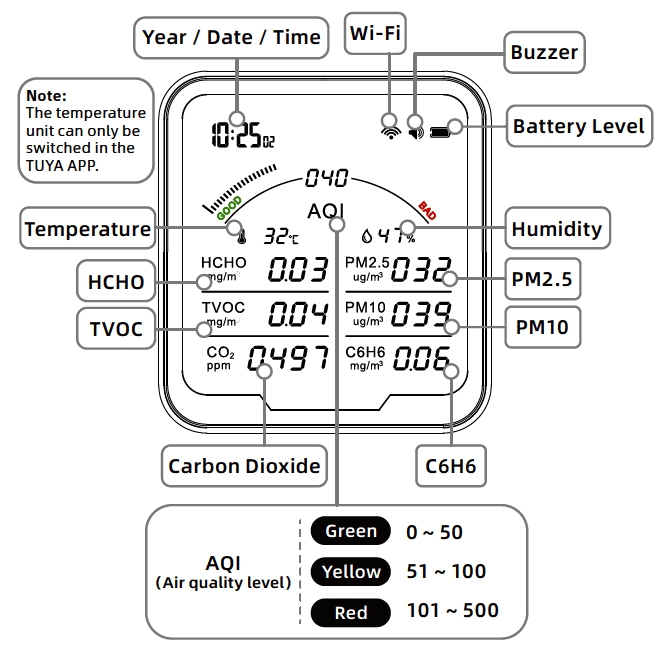Air Quality Monitor
Outdoor Air Quality Monitor, TVOC/CO/CO2/HCHO/Humidity/Temperature
Smart Air Quality Monitor, CO2/HCHO/TVOC/PM2.5/PM1.0/PM10
Air Quality Monitor for Home, CO2/HCHO/TVOC/C6H6/PM10/PM2.5
Indoor Air Quality Monitor, CO2/Temp/Hum/AQI/HCHO/PM2.5/PM10/TVOC
Ambient Air Quality Monitor, PM2.5/PM10/CO2/AOI/Temp/RH
CO2 Air Quality Monitor, PM2.5/HCHO/TVOC/Temperature/Humidity
Wifi Air Quality Monitor, CO2/PM2.5/PM10/PM1.0/Temperature/Humidity
House Air Quality Monitor, PM2.5/Temperature/Humidity
Portable Air Quality Monitor, HCHO/TVOC/Temperature/Humidity
Air quality has become a growing concern as urbanization, industrial activities, and vehicle emissions continue to contribute to the decline in the quality of the air we breathe. The impact of poor air quality on health, particularly in urban environments, cannot be overstated. With rising awareness about the dangers of air pollution, the demand for tools that can help monitor and improve air quality has surged. Among these tools, the air quality monitor stands out as a crucial device in both residential and commercial settings.
What is an air quality detector?
An air quality monitor is a device designed to measure the concentration of various pollutants in the air. These pollutants can range from particulate matter (PM2.5 and PM10) to gases like carbon monoxide (CO), carbon dioxide (CO2), nitrogen dioxide (NO2), ozone (O3), and volatile organic compounds (VOCs). Some advanced models can even detect humidity levels and temperature, providing a comprehensive view of the air quality in a given environment.
Air Quality Monitor Working Principle
An air quality monitor detects and reports the concentration of pollutants in the air using a series of sensors and analytical techniques. It primarily relies on various sensors to identify different types of pollutants. For example, optical sensors detect particulate matter (such as PM2.5 and PM10) using light scattering methods, while electrochemical sensors measure gaseous pollutants (like nitrogen dioxide, carbon monoxide, and ozone) through chemical reactions that generate a current proportional to the pollutant concentration. Additionally, infrared sensors are used to measure carbon dioxide levels, and metal oxide semiconductor (MOS) sensors detect volatile organic compounds (VOCs). These sensors work by sampling air from the environment, and the collected air samples are then analyzed to measure pollutant concentrations. The signals detected by the sensors are processed by a built-in microprocessor, which converts the analog signals into digital data and calculates pollutant levels. This data is typically displayed in real-time on the monitor's screen or accessed remotely via a smartphone app. If pollutant concentrations exceed safe thresholds, the monitor issues alerts to prompt users to take protective actions. Some advanced air quality monitors also feature data storage capabilities, allowing them to record air quality over time for further analysis or report generation. To ensure accuracy, these devices require periodic calibration, which adjusts the sensor readings. By integrating these technologies, air quality monitors can provide real-time monitoring of air quality, helping users to quickly assess and improve the air in their surroundings.

Why air quality monitors are important?
The importance of air quality monitors cannot be overstated, especially in the context of increasing air pollution. Here are several key aspects of their importance:
- Protecting Health: Pollutants in the air, such as PM2.5, PM10, carbon dioxide, carbon monoxide, and volatile organic compounds, directly impact human health, particularly for vulnerable groups like the elderly, children, and those with respiratory conditions. Air quality monitors provide real-time data on the concentration of harmful substances, enabling people to take immediate protective measures, such as using air purifiers, closing windows, or temporarily leaving polluted areas, thereby effectively safeguarding health.
- Improving Quality of Life: Good air quality is crucial for enhancing the quality of life. Air quality monitors help users understand the condition of indoor or outdoor air, allowing them to adjust their living habits and environment—such as increasing ventilation or using eco-friendly materials—to improve the air quality in their surroundings.
- Environmental Protection and Public Health: Air quality monitors are used by governments and environmental agencies to monitor air pollution levels in cities or regions, helping to formulate and adjust policies to improve air quality. This is essential for preventing environmental degradation and ensuring public health. Additionally, real-time monitoring data can help urban residents stay informed about air quality conditions, reducing outdoor activities or taking protective measures when necessary.
- Enhancing Workplace Safety: In industrial and laboratory environments, the air may contain high concentrations of harmful substances such as chemicals and dust. Air quality monitors help businesses and factories monitor air quality in real-time, ensuring workplace safety and reducing the occurrence of occupational diseases.
- Data Support and Decision-Making: Air quality monitors can record long-term air quality data, which is crucial for studying the long-term effects of air pollution on human health and for developing air quality improvement measures. For policymakers and researchers, this data serves as an important reference.
- Raising Public Environmental Awareness: Air quality monitors are not just monitoring tools; they can also display real-time data that allows the public to directly perceive the severity of air pollution. This can raise environmental awareness and encourage more people to participate in environmental protection actions.
Air Quality Tester Applications
Air quality monitors are essential in various environments to ensure safety and health by detecting harmful pollutants. They are widely used in both indoor and outdoor settings, such as homes, offices, and industrial sites, where they monitor pollutants like VOCs, dust, and carbon monoxide. In urban areas, these monitors help track pollution from traffic and industrial activities, while in specialized environments like laboratories, woodshops, and construction sites, they play a critical role in maintaining air quality. Additionally, they are integrated into HVAC systems to manage and improve the air circulating within buildings, safeguarding the well-being of occupants.











